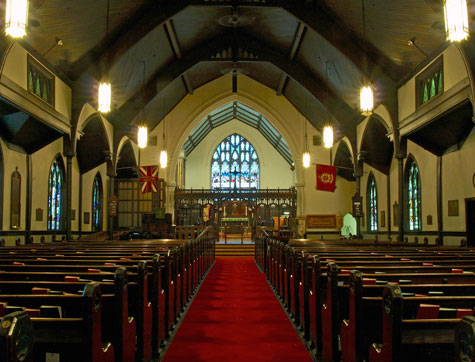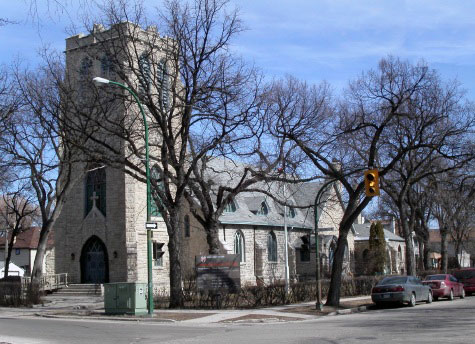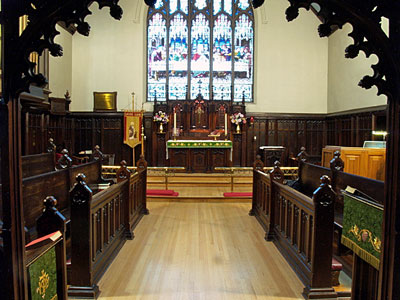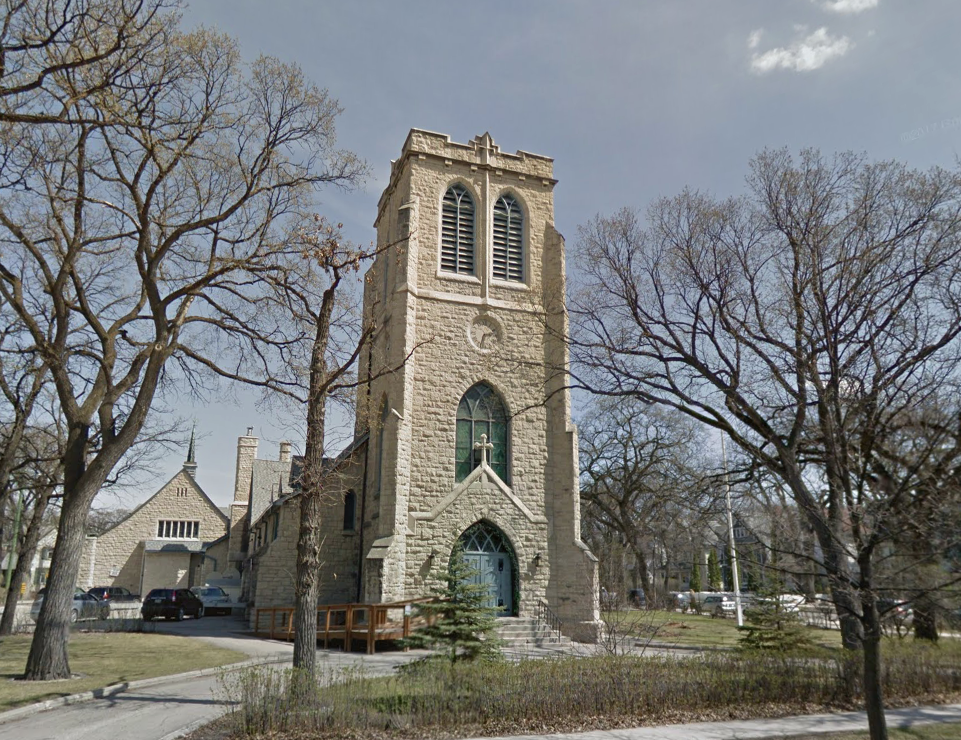St. Luke's Anglican Church
| Address: | 130 Nassau Street North |
|---|---|
| Original Use: | Place of worship |
| Constructed: | 1905 |
| Other Work: | 1909, 1914 |
| Architects: |
|
More Information
St. Luke’s Anglican Church opened on a snowy February day in 1905, welcoming members of the area’s growing Anglican congregation. The Parish itself had been operating in Fort Rouge since 1897, but the earlier buildings were nowhere near as grand as this Charles Bridgman design.
Generally, early church architecture in Winnipeg favoured the highly ornamental Gothic Revival style but Bridgman steered away from this for the design of St. Luke’s. Instead, the building bears elements of the late Gothic Revival Style, with a preference for simplified silhouettes and less dramatic ornamentation. The church’s entrance, facing Nassau Street, is striking with its crenellated tower and doorway capped with a Gothic pointed arch. Windows on the tower are symmetrical on all sides, and clocks mark the north and west facades. The unified building is a solid, horizontal structure in the manner of English parish churches. There is an expressive use of materials in the church’s fine stonework and elements such as oversized buttresses. The church features broad pointed windows, Gothic detailing and a large parish hall.
Initial construction cost $25,000, though later additions bumped the total cost up closer to $80,000. The tower, added in 1909, cost an extra $15,000 and the creation of a new school building on the eastern portion of the building in 1914 cost $38,600. Solid stone was used on all parts of the building, though artificial accent stones were used on the 1914 school hall to cut down on construction costs.
The interior includes a wooden rood (choir) screen designed by architect C.W.U. Chivers and stained-glass windows by Robert McCausland Ltd. of Toronto, and Morris and Co. of England.
The building’s presence has been a mainstay on both Stradbrook Avenue and Nassau Street for over a century, and it has been designated as both a municipal and provincial historic site.
Design Characteristics
| Style: | Late Gothic Revival |
|---|---|
| Neighbourhood: | Osborne Village |
- Moderately low, sprawling form incorporating two distinct components: the elongated church with a front bell tower and various ancillary volumes and the high, rectangular one-and-a-half-storey parish hall
- Highly varied roofline, punctuated by the tower, tall stone chimneys and gable dormers, including long flared gable roofs, hipped, flared pyramidal and flat roofs over subsidiary volumes
- Exceptional stonework throughout, including rusticated limestone walls, buttresses, pilasters, window surrounds, contrasted by smooth-cut stone details such as banding elements, offsets, etc.
- Key elements that define the heritage character of the church include:
- The formal entrance tower with its large diagonal buttresses, crenellated parapet and double doors beneath a stone pediment and Latin cross
- The major Gothic Revival features, including doors, windows and belfry openings in pointed arches, wooden tracery in windows and transoms, heavy buttresses at corners and along walls, etc.
- Other fine details, such as the tower’s inset stone clocks, modillioned cornice and inscribed cornerstone, stone foils, metal door hardware, modestly adorned dormer bargeboards, etc.
- The largely unaltered interior layout of a front vestibule, the nave with a high vaulted ceiling and wide centre aisle, a raised chancel and altar, side vestibules, offices, hallways, basement staircases, etc.
- The nave’s arched-brace ceiling with hammerbeams, with planks laid diagonally and darkly stained
- The continuation of Gothic motifs, including smooth plaster walls articulated by pointed arched arcades with piers, pointed arches with carved detailing above the chancel, doorways and recessed windows, etc.
- The exquisite features and finishes, including the stained-glass windows, the carved wooden rood screen and reredos, the oak-panelled chancel and other dark-stained woodwork throughout
- Source: Historic Places Canada
Sources
Susan Algie and James Wagner. Osborne Village: An Architectural Tour. Winnipeg Architecture Foundation, 2022



